
Lenore "Lee" Krasner was an American painter and visual artist active primarily in New York whose work has been associated with the Abstract Expressionist movement. She received her early academic training at the Women's Art School of Cooper Union, and the National Academy of Design from 1928 to 1932. Krasner's exposure to Post-Impressionism at the newly opened Museum of Modern Art in 1929 led to a sustained interest in modern art. In 1937, she enrolled in classes taught by Hans Hofmann, which led her to integrate influences of Cubism into her paintings. During the Great Depression, Krasner joined the Works Progress Administration's Federal Art Project, transitioning to war propaganda artworks during the War Services era.
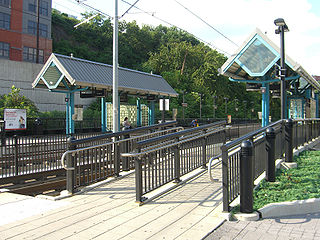
2nd Street station is a station on the Hudson–Bergen Light Rail (HBLR) located west of Marshall Street near the foot of Paterson Plank Road in Hoboken, New Jersey. There are two tracks and two side platforms.
Wangechi Mutu is a Kenyan American visual artist, known primarily for her painting, sculpture, film, and performance work. Born in Kenya, Mutu now splits her time between her studio there in Nairobi and her studio in Brooklyn, New York, where she has lived and worked for over 20 years. Mutu's work has directed the female body as subject through collage painting, immersive installation, and live and video performance while exploring questions of self-image, gender constructs, cultural trauma, and environmental destruction and notions of beauty and power.

The Montclair Art Museum (MAM) is located in Montclair in Essex County, New Jersey and holds a collection of over 12,000 objects showcasing American and Native North American art. Through its public programs, art classes, and exhibitions, MAM strives to create experiences that inspire, challenge, and foster community to shape our shared future.

Yvonne Helene Jacquette was an American painter, printmaker, and educator. She was known in particular for her depictions of aerial landscapes, especially her low-altitude and oblique aerial views of cities or towns, often painted using a distinctive, pointillistic technique. Through her marriage with Rudy Burckhardt, she was a member of the Burckhardt family by marriage. Her son is Tom Burckhardt.
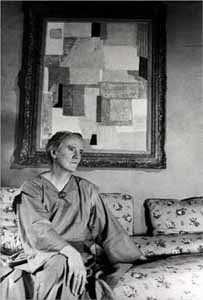
Anne Ryan (1889–1954) was an American Abstract Expressionist artist associated with the New York School. Her first contact with the New York City avant-garde came in 1941 when she joined the Atelier 17, a famous printmaking workshop that the British artist Stanley William Hayter had established in Paris in the 1930s and then brought to New York when France fell to the Nazis. The great turning point in Ryan's development occurred after the war, in 1948. She was 57 years old when she saw the collages of Kurt Schwitters at the Rose Fried Gallery, in New York City, in 1948. She right away dedicated herself to this newly discovered medium. Since Anne Ryan was a poet, according to Deborah Solomon, in Kurt Schwitters's collages “she recognized the visual equivalent of her sonnets – discrete images packed together in an extremely compressed space.” When six years later Ryan died, her work in this medium numbered over 400 pieces.
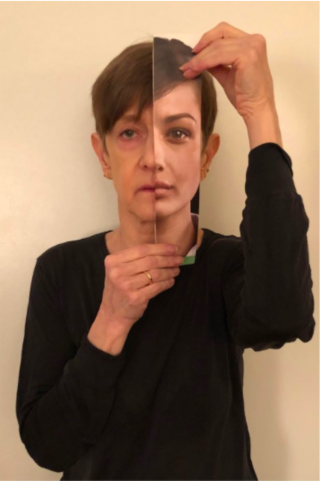
Judith Henry is a New York-based artist that creates multimedia art works exploring interior versus public self. Henry often uses newspapers, telephone books, and film reels. She also uses snapshot photography. After graduating from college, she moved to New York and married artist Jaime Davidovich, with whom she has two daughters. She currently lives in Williamsburg, Brooklyn.

Honoré Desmond Sharrer was an American artist. She first received public acclaim in 1950 for her painting Tribute to the American Working People, a five-image polyptych conceived in the form of a Renaissance altarpiece, except that its central figure is a factory worker and not a saint. Flanking this central figure are smaller scenes of ordinary people—at a picnic, in a parlor, on a farm and in the schoolroom. Meticulously painted in oil on composition board in a style and color palette reminiscent of the Flemish Masters, the finished work is more than six feet long and three feet high and took her five years to complete. It was the subject of a 2007 retrospective at the Smithsonian Institution and is part of the permanent collection of the Smithsonian American Art Museum.
May Wilson was an American artist and figure in the 1960s to 1990s New York City avant-garde art world. A pioneer of the feminist and mail art movement, she is best known for her Surrealist junk assemblages and her "Ridiculous Portrait" photocollages.

Tania was a Polish-born Jewish American abstract painter, sculptor, collage artist and painter of city walls.
Emmy Lichtwitz Krasso was an Austrian-American artist. Her artwork ranged from the Old Master style to Expressionism.

Hedy Klineman is a German-born American painter living in New York City. She has been painting for over 40 years and is known for portraits of New York celebrities and colorful works based on Asian Buddha's and deities created with silkscreen on canvas done in a manner influenced by her friend Andy Warhol. Her paintings have been shown at Tibet House US, Patterson Museum of Contemporary Art and The New England Museum of Contemporary Art.

After the Bath, Woman Drying Herself is a pastel drawing by Edgar Degas, made between 1890 and 1895. Since 1959, it has been in the collection of the National Gallery, London. This work is one in a series of pastels and oils that Degas created depicting female nudes. Originally, Degas exhibited his works at Impressionist exhibitions in Paris, where he gained a loyal following.
Jenny Lynn, is an American photographer. She works and lives in Philadelphia, Pennsylvania.
Cicely Cottingham is an American artist who lives and works in West Orange, New Jersey. She has received numerous awards for her paintings and works on paper and is represented in several public collections. Cottingham is a cofounder (1991) of Aljira Design, a design studio and revenue stream through 2009 for the nonprofit art center Aljira, a Center for Contemporary Art in Newark, NJ.
Carole Marie Byard was an American visual artist, illustrator, and photographer. She was an award-winning illustrator of children's books, and the recipient of a Caldecott Honor, as well as multiple Coretta Scott King Awards.
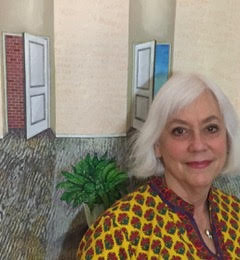
Robin Tewes is a Queens-born, New York City-based artist, known since the early 1980s for her representational paintings of frozen, narrative-like moments. She has shown her work in numerous solo exhibitions in New York City, as well as nationally and internationally, and exhibited at venues including P.S. 1, the Museum of Modern Art, the Whitney Museum, The Drawing Center, and the Central Academy of Fine Arts (Beijing), among many. Her work has been widely discussed in publications including Artforum, Art in America, ARTnews, Tema Celeste, the New York Times, the Los Angeles Times, and the Village Voice. Tewes was a founding member of the P.S. 122 Painting Association. She has been recognized with a Pollock-Krasner Foundation Fellowship (2015) and Painting Award (2008), an Adolph and Esther Gottlieb Foundation Award (2007), and inclusion in the Smithsonian Archives of American Art in 2016.
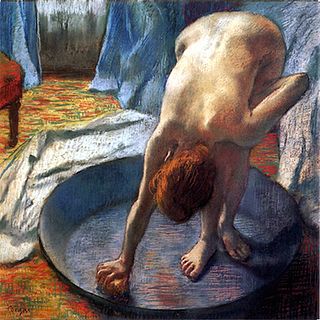
Woman in a Tub is one of a suite of pastels on paper created by the French painter Edgar Degas in the 1880s and is in the collection of the Hill-Stead Museum in Connecticut. The suite of pastels all featured nude women "bathing, washing, drying, wiping themselves, combing their hair or having it combed" and were created in readiness for the sixth and final Impressionist Exhibition of 1886.

Serena Bocchino is an American contemporary abstract artist working primarily in the realm of painting. Her highly expressionistic style shows a variety of influences from Abstract Expressionism and dance, to Fluxus and jazz music. Like her varied influences, her process is highly improvisational yet technically informed – consisting of language created through an intermingled vocabulary of color, media and technique.
The Untitled Space gallery is an art gallery in the Tribeca neighborhood of New York City founded by curator, photographer, magazine editor, and multidisciplinary artist Indira Cesarine in 2015. It exhibits the work of contemporary artists working in media including painting, sculpture, photography, video, printmaking, mixed media, and performance art.












